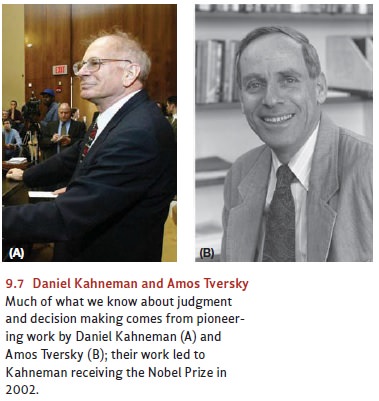Chapter: Psychology: Thinking
Judgment: Drawing Conclusions from Experience
JUDGMENT: DRAWING
CONCLUSIONS FROM EXPERIENCE
So far we’ve been discussing the
content of thought, with an emphasis on how thoughts are represented in the
mind. Just as important, though, are the processes of thought—what
psychologists call directed thinking—the
ways people draw conclu-sions or make decisions. What’s more, these two broad
topics—the contents of thought and the processes—are linked in important ways.
As we’ve discussed, representing ideas with images will highlight visual
appearance in our thoughts and thus may call to mind objects with similar
appearance. Likewise, representing ideas as propositions will cause activation
to spread to other, associated, nodes; and this too can guide our thoughts in
one direction rather than another.
But, of course, the flow of our thoughts
also depends on what we’re trying to accom-plish in our thinking. So it will be
useful to divide our discussion of thought processes into four sections, each
corresponding to a type of goal in our thinking: We will, therefore, con-sider judgment, reasoning, decision making,
and problem solving. Let’s begin with
judgment.
The term judgment refers to the various steps we use when trying to reach
beyond the evidence we’ve encountered so far, and to draw conclusions from that
evidence. Judgment, by its nature, involves some degree of extrapolation
because we’re going beyond the evi-dence; and as such, this always involves
some risk that the extrapolation will be mistaken. If, for example, we know
that Jane has enjoyed many trips to the beach, we might draw the conclusion
that she will always enjoy such trips. But there’s no guarantee here, and it’s
surely possible that her view of the beach might change. Likewise, if you have,
in the past, preferred spending time with quiet people, you might draw a conclusion
about how much you’d enjoy an evening with Sid, who’s quite loud. But here,
too, there’s no guarantee—and perhaps you’ll have a great time with Sid.
Even with these risks, we
routinely rely on judgment to reach beyond the evidence we’ve gathered so far—and
so we do make fore-casts about the next beach trip, whether the evening with
Sid would be fun, and more. But how do we proceed in making these judgments?
Research suggests that we often rely on a small set of shortcuts called judgment heuristics. The wordheuristics,borrowed from computer
sci-ence, refers to a strategy that’s relatively efficient but occasionally
leads to error. Heuristics, in other words, offer a trade-off between
efficiency and accuracy, helping us to make judgments more quickly—but at the
price of occasional mistakes.
Let’s start our discussion with
two of these shortcuts—the avail-ability and representativeness heuristics, first
described by Amos Tverskyand Daniel Kahneman (Figure 9.7); their research in
this domain is

part of the scholarship that led
to Kahneman’s winning the Nobel Prize in 2002.* As we’ll see, these heuristics
are effective but often do lead to errors, and so we’ll turn next to the
question of whether—and in what circumstances—people can rise above the
shortcuts, and use more accurate judgment strategies.
Related Topics